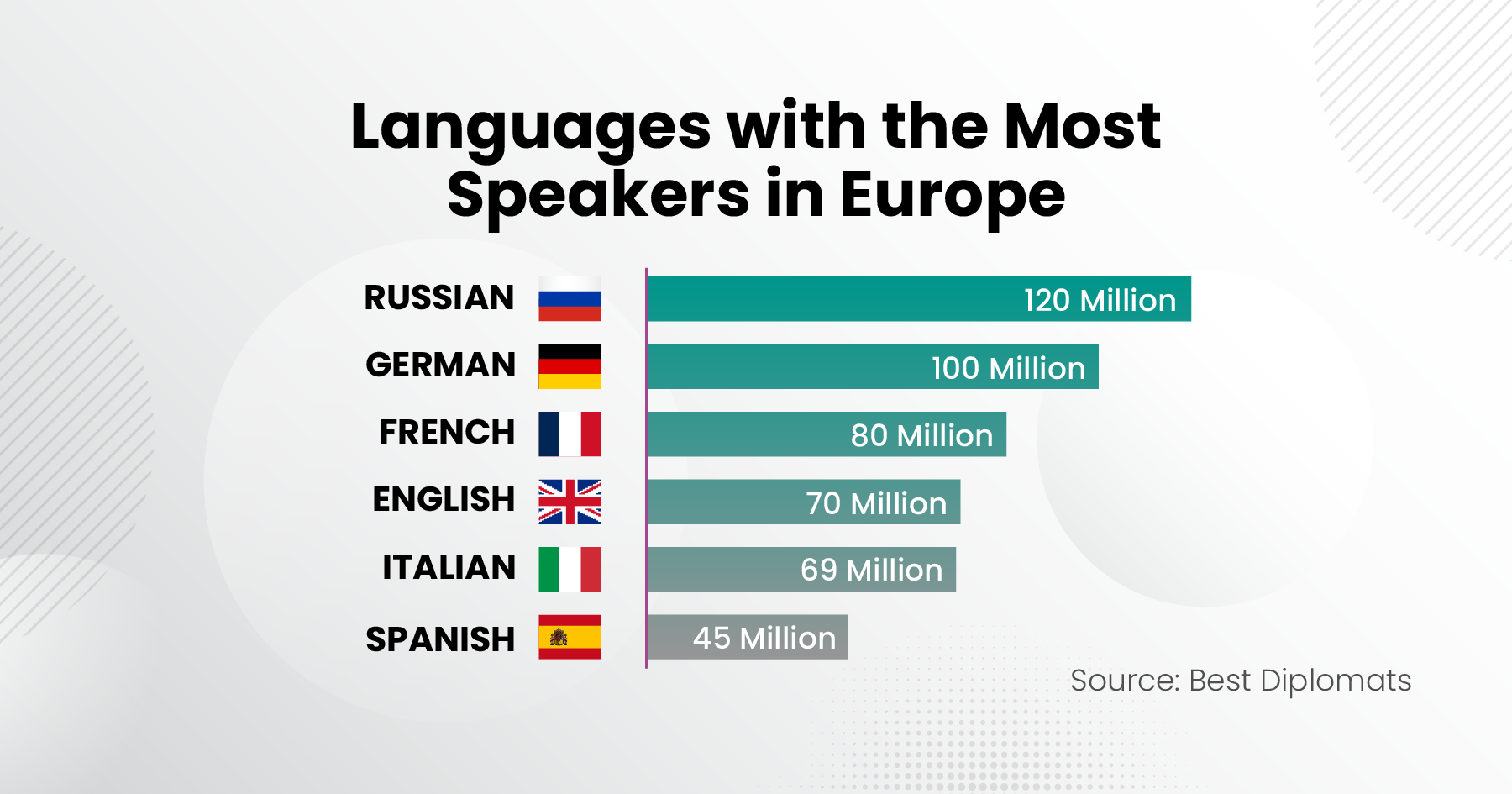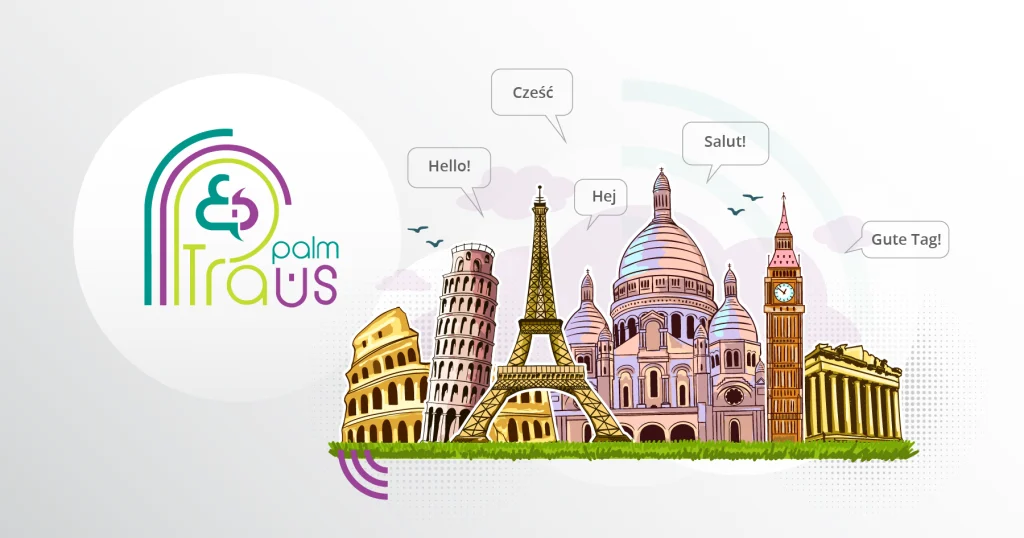While English serves as the global lingua franca in business and academia, Europe is home to a rich variety of languages that are among the most commonly spoken languages in the world.
And that’s why it’s important not to forget the diverse languages spoken in Europe, as translating and localizing content into these languages opens the door to new opportunities, especially for businesses with international expansion ambitions.
This guide offers an insightful overview of Europe’s diverse languages, covering their history, major language families, the 24 official languages of the European Union, and their vital role in business and market localization.
A Quick History of European Languages
The history of European languages can be traced back to the Eurasian Steppe, where, thousands of years ago, a small group of nomadic herders spoke a single language.
Linguists believe that this language, known as Proto-Indo-European, was the common ancestor of many languages spoken today.

Proto-Indo-European is thought to have existed around 4000 BCE. Over time, as groups of people migrated across vast regions, this language evolved and branched out into what we now call the Indo-European language family. Today, this family includes languages like English, Hindi, Russian, and Spanish, among many others.

Surprisingly, Proto-Indo-European was not the oldest language in Europe! In fact, the ancient languages have mostly been lost over time due to the absence of historical documentation of their existence.
Basque, a language isolated from Europe’s pre-Indo-European roots, is the only one to have survived extinction. Geographically, Indo-European languages are thought to have originated in West Central Asia.
Major European Language Families
Languages spoken in Europe belong to three main sub-groups, which are Indo-European, Uralic, and Basque. Now, let’s explore each of these languages together!
– Indo-European Languages
The Indo-European family is the largest and most widespread group of spoken languages in the world, and it serves as the main language of communication for the vast majority of European countries today.
It is divided into several branches, with eight groups still actively spoken in Europe. It includes languages like Romance, Germanic, Slavic, Baltic, Celtic, Hellenic, Albanian, and Armenian.
-
Romance Languages
Spanish, French, Italian, and Portuguese are the most widely spoken Romance languages. The Spanish language originated in the Iberian Peninsula and is now spoken by a large population, primarily in South and Central America, making it one of the world’s most spoken languages.
Portuguese, which evolved from Galician-Portuguese, is widely spoken, especially in Brazil and parts of Africa. French developed from Gallo-Romance dialects and is spoken across Europe, Africa, and Canada. Italian, a descendant of Vulgar Latin, was shaped by the Tuscan dialect and is spoken mainly in Italy, with communities in the United States and Brazil.
-
Germanic Languages
The Germanic languages include English, the most widely spoken with 1.338 billion speakers worldwide (including native and non-native speakers), as well as German, Dutch (including Flemish), Swedish, Danish, Norwegian, and Afrikaans.
-
Slavic Languages
Russian, Ukrainian, Polish, Belarusian, Czech, Bulgarian, Croatian, Serbian, Slovak, and others are all part of the Indo-European family’s Slavic languages. Russian is the most widely spoken, ranking as the world’s eighth most spoken language by total speakers, with 258 million speakers.
There are other Indo-European branches present in Europe including the Celtic languages (like Irish and Welsh), Hellenic (Greek), Baltic (Latvian and Lithuanian), Albanian, and Armenian.

-
Uralic Languages
There are two main branches of Uralic languages, which belong to a significant family of European languages. The Finnic languages group includes Finnish, Estonian, Sami, Mari, Moksha, Erzya, Komi, and Udmurt. In contrast, Hungarian, Khanty, and Mansi are part of the Ugric group. Additionally, the Samoyedic languages are classified as Uralic languages found in Europe.
-
Basque
Basque is a unique language family in Europe. Although it has five major dialects, it is classified as a language isolate, meaning it has no known relatives. The Basque language is primarily spoken in the Basque Country, which is located in the westernmost Pyrenees of Northern Spain and Southwest France.
Due to its distinct origins, Basque grammar varies significantly from that of most other European languages. However, about 40% of its vocabulary is derived from the Romance languages spoken in the surrounding regions, which have significantly influenced Basque.
Top 6 Languages Spoken in Europe
English is spoken by 70 million people in Europe and 1.5 billion worldwide. It is the primary language in the United Kingdom and Ireland, but it is also spoken as a second language in Europe.
Spanish is spoken by 45 million speakers in Europe, whereas the number of native speakers globally is approximately 559 million people. It is the main language in most of Spain, South and Central America, and in U.S. states with significant Hispanic populations.
Russian continues to be a major language in Eastern Europe, with 120 million people in the region and 225 million native language speakers globally. It is roughly prevalent in Belarus, Ukraine, and parts of Central Asia.

The language of love, French, is widely spoken in France, Belgium, Switzerland, and Luxembourg, with its influence stretching across Europe and many former colonies. There are around 80 million speakers in Europe and 309 million in the world.
Germany’s population size makes Germany the most spoken mother tongue in Europe, with 100 million speakers and about 135 million globally. Spoken primarily in Germany, Switzerland, Austria, and parts of Belgium and Luxembourg.
Italian is spoken by 69 million speakers in the European Union and has around 85 million native language speakers worldwide, primarily widespread in Italy and parts of Switzerland.
24 Official Languages of the European Union
The European Union is well-known for its cultural and linguistic diversity, featuring 24 official languages. The languages spoken in European countries are not only a means of communication, but a fundamental part of the identity and cultural heritage. For this reason, the EU encourages multilingualism in its programs and institutional operations.
The table below is a list of 24 official languages recognized by the EU:
|
Slavic Languages |
Bulgarian, Croatian, Czech, Polish, Slovak, Slovenian |
|---|---|
|
Germanic Languages |
Danish, Dutch, English, German, Swedish |
|
Romance Languages |
French, Italian, Portuguese, Romanian, Spanish |
|
Baltic Languages |
Latvian, Lithuanian |
|
Finno-Ugric Languages |
Estonian, Finnish, Hungarian |
|
Greek Languages |
Greek |
|
Celtic Languages |
Irish |
|
Semitic Languages |
Maltese |
The Most Useful European Languages for Business
-
German
Germany is the largest economy in the European Union and a home to the headquarters of the European Central Bank. German language is the main language spoken in Europe by several economically important countries, including Austria, Belgium, Switzerland, Luxembourg, and Liechtenstein.
It is a global economic powerhouse in some of the world’s innovative industries. Iconic brands such as Mercedes, Volkswagen, and BMW are great examples that reflect Germany’s dominance in the automotive industry.
But Germany’s influence goes far beyond luxury cars; it is also a key player in the renewable energy technology, scientific research, soft sciences, and medical equipment production sectors.

-
Italian
Italy is a global leader in the fashion industry, with a rich history that dates back centuries. It is a hub for designers and some of the most prominent fashion houses that set trends worldwide like Gucci, Prada, Bulgari, and Versace, known for their timeless designs and exquisite craftsmanship.
This makes Italian language crucial for business in the industry for better market insights, smoother communication with Italian partners, and stronger industry connections.
Furthermore, Italian is widely spoken outside Italy, in nations such as Switzerland, Croatia, Slovenia, and Malta. Therefore, it is one of the most useful European languages for commercial business purposes, as Italy has the second-largest manufacturing industry in Europe.

-
French
French is often considered one of the romance languages. It is commonly used in tourism, business, and diplomacy. The French-speaking world includes several countries, some of which are in Africa, such as Algeria, Morocco, and Tunisia; on the other hand, Cambodia and Vietnam within Southeast Asia.
So, if you are targeting consumers in these countries, the French language is useful as a lingua franca. In addition, it is one of the official languages of multiple international institutions like the World Trade Organization (WTO) and the United Nations (UN).
The Francophone world also involves the top five fastest-growing economies, such as Rwanda, Tanzania, Mozambique, Côte d’Ivoire, the Democratic Republic of Congo, and Ethiopia, all of which are rich in natural resources.

-
Spanish
Though Spanish might not be perceived as a language of business, it should be one of your chosen localization languages. It is highly relevant for countries in Latin America, such as Peru, Paraguay, Ecuador, the United States (US), and Mexico, where an estimated 37.6 million people speak it as their official language.
Since the US is the second-largest global economy and the Hispanic population in the US is expected to reach 111 million by 2060, the Spanish language is massively essential for the American market.
Mexico has one of the world’s most open trade networks, with extensive bilateral trade agreements. The British Council reports that Spanish is useful for 34% of United Kingdom businesses as well.

-
Portuguese
Portuguese should be taken seriously on the global business stage. Brazil, the only Portuguese-speaking country in the Americas, has a large number of Portuguese speakers.
Country-wise, Brazil is a top business destination, being the ninth largest economy in the world by GDP, with opportunities for growth.
Agriculture, aircraft and automobile production, and mineral extraction are among Brazil’s key industries.
The demand for Portuguese in the United Kingdom is also increasing, driven by potential opportunities in trade, science, education, and diplomacy.
It is gaining popularity in Asia as well, due to the region’s strong diplomatic and economic bilateral ties with Portugal and Lusophone.

Localization for European Markets
Despite many shared cultural and historical ties with the European population, the differences are more pronounced in customs, traditions, and languages.
In marketing, this diversity requires businesses to tailor content for each local audience. When brands communicate in their customer’s mother tongue, they demonstrate respect for that customer’s linguistic and cultural nuances.
Researchers have shown that 76% of consumers are more likely to purchase products with information in their native language. For this reason, localization is an important aspect of reaching customers in Europe.

The United Kingdom-based online food delivery platform Deliveroo is a great case study of a successful localization strategy for reaching the European market.
For example, Deliveroo has separate regional Instagram accounts for its audiences in France and Italy. As you can see, the social media content and written text in the visuals have been fully adapted to each locale.
Expand Your Global Reach With TransPalm’s Translation and Localization Solutions for European languages
We offer premium translation and localization services in 120+ languages worldwide, including Central and Eastern Europe. As a leading provider in the field, we guarantee clear, culturally accurate communication with high-quality, fast translations for your European audience. Reach out now and let’s enhance your global impact.





